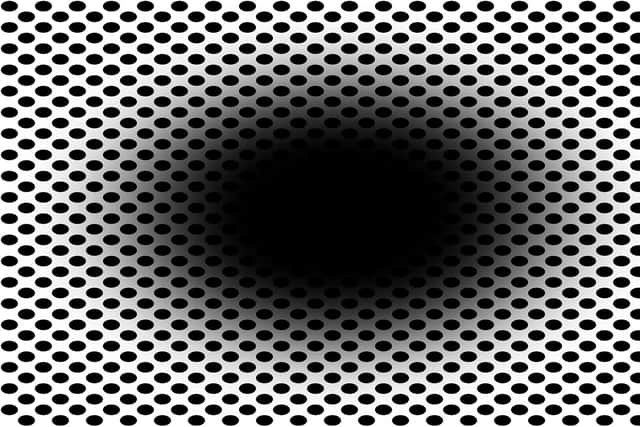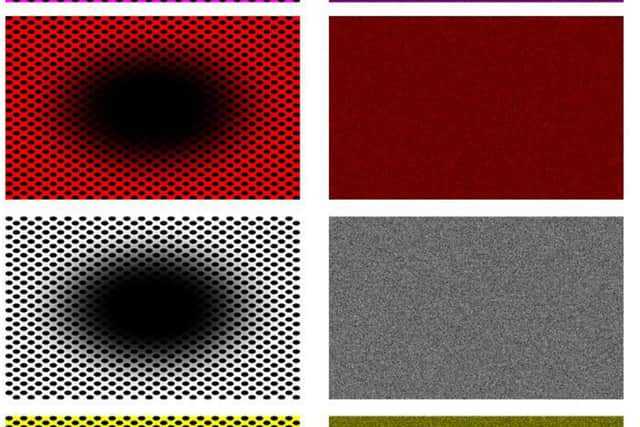What do you see? Optical illusion appears to move as the brain and eyes try to anticipate the future
and live on Freeview channel 276
Optical illusions are designed to play tricks on the mind and can be interpreted by people in different ways.
One such example is an illusion depicting a series of dots with a large black hole in the centre.
Advertisement
Advertisement
Staring at the large hole will make it seem as though the large hole is moving, growing or expaning, but actually the image is completely static.


Why does the image appear to move?
The illusion appears to be moving because the pupils in your eyes unconsciously adjust to the light in your surroundings, dilating when it is dark to capture more light, and constricting in bright light to prevent overexposure.
When looking at this illusion it may appear as if the hole is changing in size, but this is actually just caused by your pupils responding to the image.
A study published in the journal Frontiers in Human Neuroscience tested the optical illusion on 50 men and women with normal vision.
Advertisement
Advertisement
Using an infrared eye tracker, psychologists found that the greater a participant’s response to the illusion, the stronger the pupil dilation response.
The researchers hypothesise that the illusion works because the gradient on the central hole makes it appear as if the viewer is entering a dark hole or tunnel, causing the pupils to dilate.
They also found the illusion’s effect varied against different coloured backgrounds and was strongest when the black hole was on top of magenta.


Bruno Laeng, a psychology professor at the University of Oslo and an author of the study, told the New York Times: “There is no reason per se that the pupil should change in this situation, because nothing is changing in the world.
“But something clearly has changed inside the mind.”
‘The brain is trying to anticipate the future’
Advertisement
Advertisement
Visual illusions can show how our brains are trying to anticipate the future in order to perceive the present, Dr Laeng says.
It takes time for a stimulus to, such as light, to reach our sensory organs which need to send it to the brain. The brain then needs time to process this and make sense of the information.
As such, seeing an expanding hole in the illusion is not a flaw, but rather the result of the brain trying to navigate an uncertain and changing world. It is adaptive to predict the future by dilating your pupils in anticipation of going somewhere dark.
Dr Laeng explained that when the eye is confronted with a scene, the brain is “analysing what it’s seeing and building up, constructing a possible scenario and adapting to it.”
Advertisement
Advertisement
However, not everyone is taken in by the illusion, with 14% of participants in the study saying they did not see any changes or ‘movement’ when looking at the images. Dr Laeng says that a minority may only see the image in two dimensions.
Another example of a dress illusion that went viral on the internet several years ago, with some people seeing it as white and gold, while others could see blue and black.
The image, which was first posted on Tumblr, quickly spread across Facebook and Twitter feeds across the world as people argued over what colour it was.
Cedar Riener, associate professor of psychology at Randolph-Macon College, explained to BuzzFeed that the differences in colour perception are related to how our brains interpret the "quantity of light that comes into our retina."
Advertisement
Advertisement
This luminance is a combination of how much light is shining on an object and how much it reflects off of the object’s surface.
It means that our individual sensitivity to the background lighting of the photo affects how we see the object in the image, as with the expanding hole illusion.
Reiner explained: “Some people are deciding that there is a fair amount of illumination on a blue and black (or less reflective) dress.
"Other people are deciding that it is less illumination on a white/gold dress (it is in shadow, but more reflective)."
Advertisement
Advertisement
Dr Laeng added: “The information we get from the world is quite indeterminate.
“The brain goes into a constant guessing mode, we have to sort of come up with the best solution, but there are several possibilities for the same type of input.”
Comment Guidelines
National World encourages reader discussion on our stories. User feedback, insights and back-and-forth exchanges add a rich layer of context to reporting. Please review our Community Guidelines before commenting.
